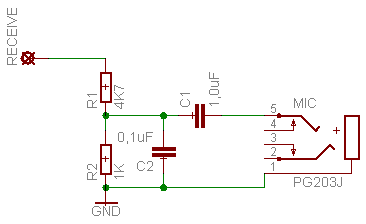Hardware
To be able to analyze an input signal, the signal has to be adapted to the microphone input levels. This means it has to be transformed to a low level AC-signal. Fortunately this is quite easy, once you have the signal, you only need two resistors to lower the signal level and a capacitor ro remove the DC-component. The typical circuit input circuit looks like this:
The capacitor C2 is usually not needed, it is used to remove HF interference from the computer if the signal source is a sensitive radio receiver.
IR-Remotes
Infrared remote controls is a typical example on protocols that can be decoded. The protocols used are typically quite simple with pulse lengths around 1 ms. The signals are almost always AM-decoded over a base frequency of 38KHz. To decode the real signal we need a decoder. Fortunately, these decoders are very cheap and easy to use.
RF-Remotes
Radio remotes, used for example for remote lamp switches use similar protocols as IR-Remotes, in some cases they actually reuse the same protocols. To be able to use these protocols we need a radio receiver which decodes the RF-signal.
In Europe, the most common frequency used is 433.92MHz. This frequency is for example used by X10, Nexa, Detronic, WaveMan. It is possible to buy receiver chips for this frequency, but the cheapest and easiest way is actually to buy some cheap device which use the protocol and “hack” the receiver. Then you get receiver, case and battery holder for the same price as a receiver card. A typical example is the UPM-unit (see here) for around 10€ you get the receiver and a wireless thermometer transmitter.

